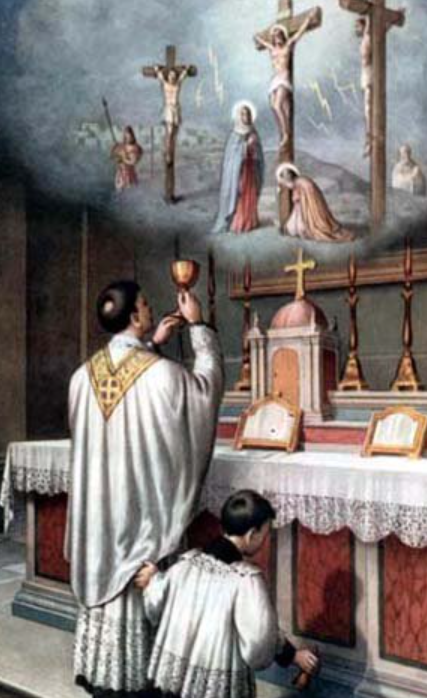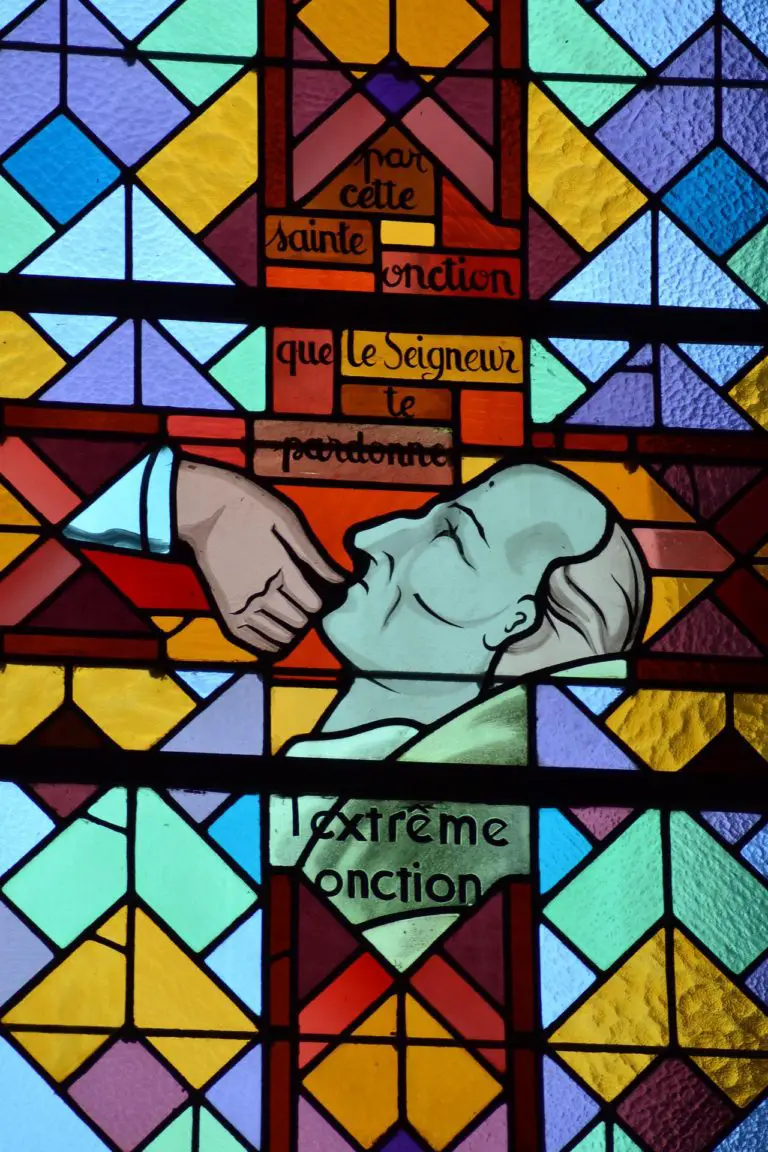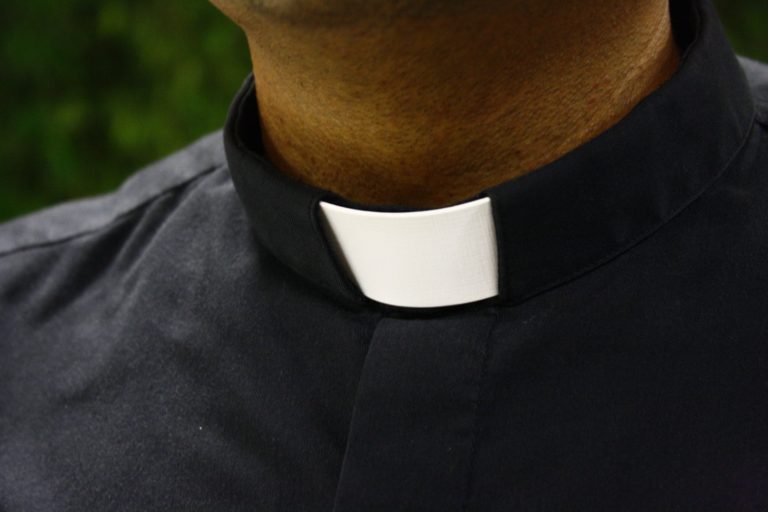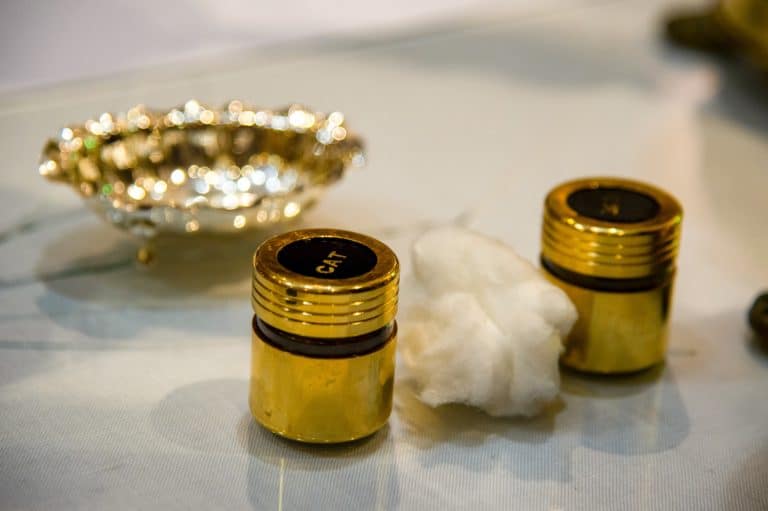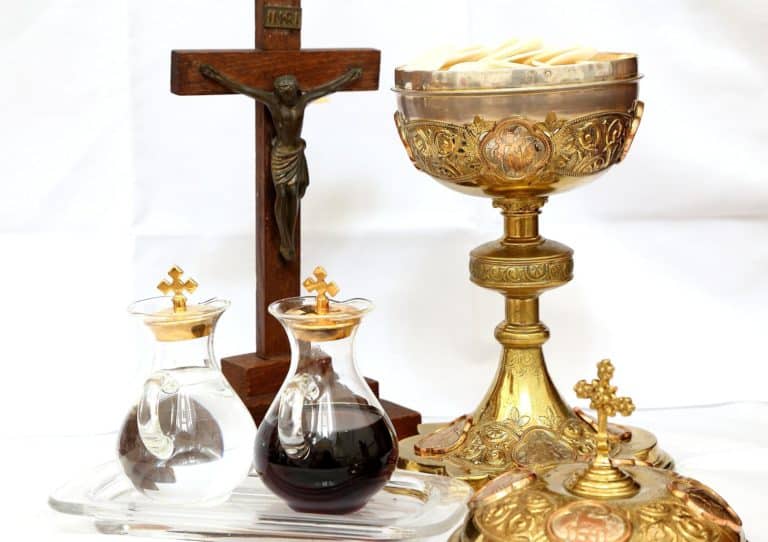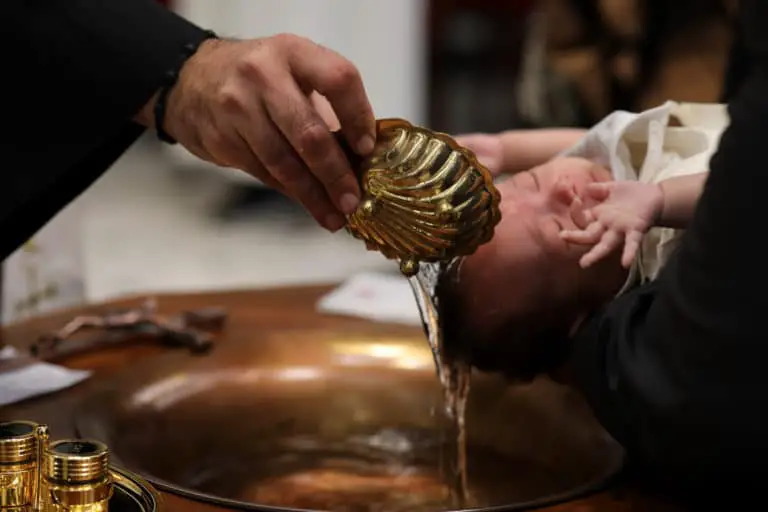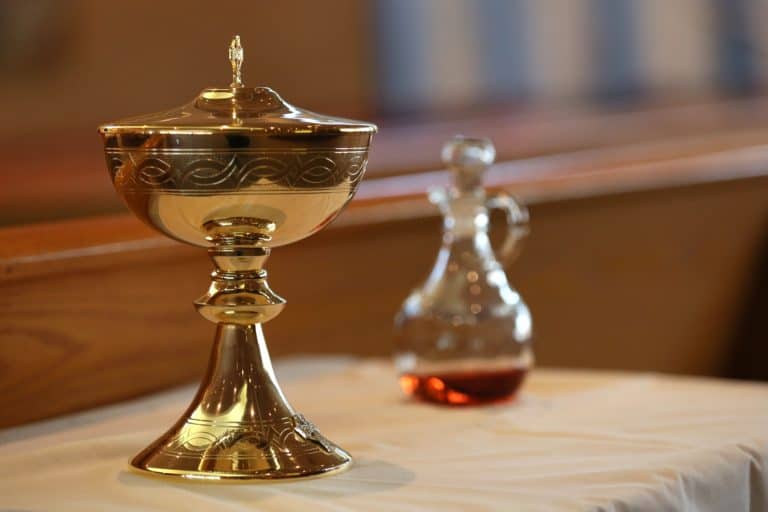Are there Biblical Roots for the both the TLM and Novus Ordo Catholic Mass?
When examining the history of Catholic worship, one cannot help but notice the profound contrast between the traditional Latin Mass and the Novus Ordo. The traditional Latin Mass missal connects us to a sacred tradition with roots stretching back to apostolic times, while the New Mass emerged only in the 1960s through committee work rather than organic development over centuries.
The Traditional Latin Mass directs our focus vertically toward God, whereas the Novus Ordo often emphasizes a horizontal orientation toward the congregation. This fundamental difference reveals two distinct spiritual approaches to worship within the same Church.
The comparison between Traditional Latin Mass and Novus Ordo goes far beyond mere aesthetics or language preferences. As Catholics, we believe in the sacrificial nature of the Mass, yet how this sacrifice is presented differs notably between these two forms.
The Traditional Latin Mass maintains explicit sacrificial language throughout its prayers, while the distinction between Latin Mass and Novus Ordo often reveals how the New Mass is frequently understood as more of a communal meal. Cardinal Ratzinger (later Pope Benedict XVI) spoke directly to this issue when he observed that the crisis in the Church largely stems from the disintegration of the liturgy, highlighting the profound significance of these differences.
What does the Bible teach us about proper worship? How did the early Christians celebrate the Eucharist? Throughout this article, I will explore the biblical and historical origins of both the traditional Mass and the meaning of the Novus Ordo. We’ll examine how the Traditional Latin Mass includes abundant references to sin, judgment, and saintly intercession that are less emphasized in the New Mass. Furthermore, we’ll discover why the fixed nature of the Tridentine Mass versus Novus Ordo creates a consistency that safeguards doctrine and fosters deeper reverence among the faithful.
What are the Origins of the Traditional Latin Mass?
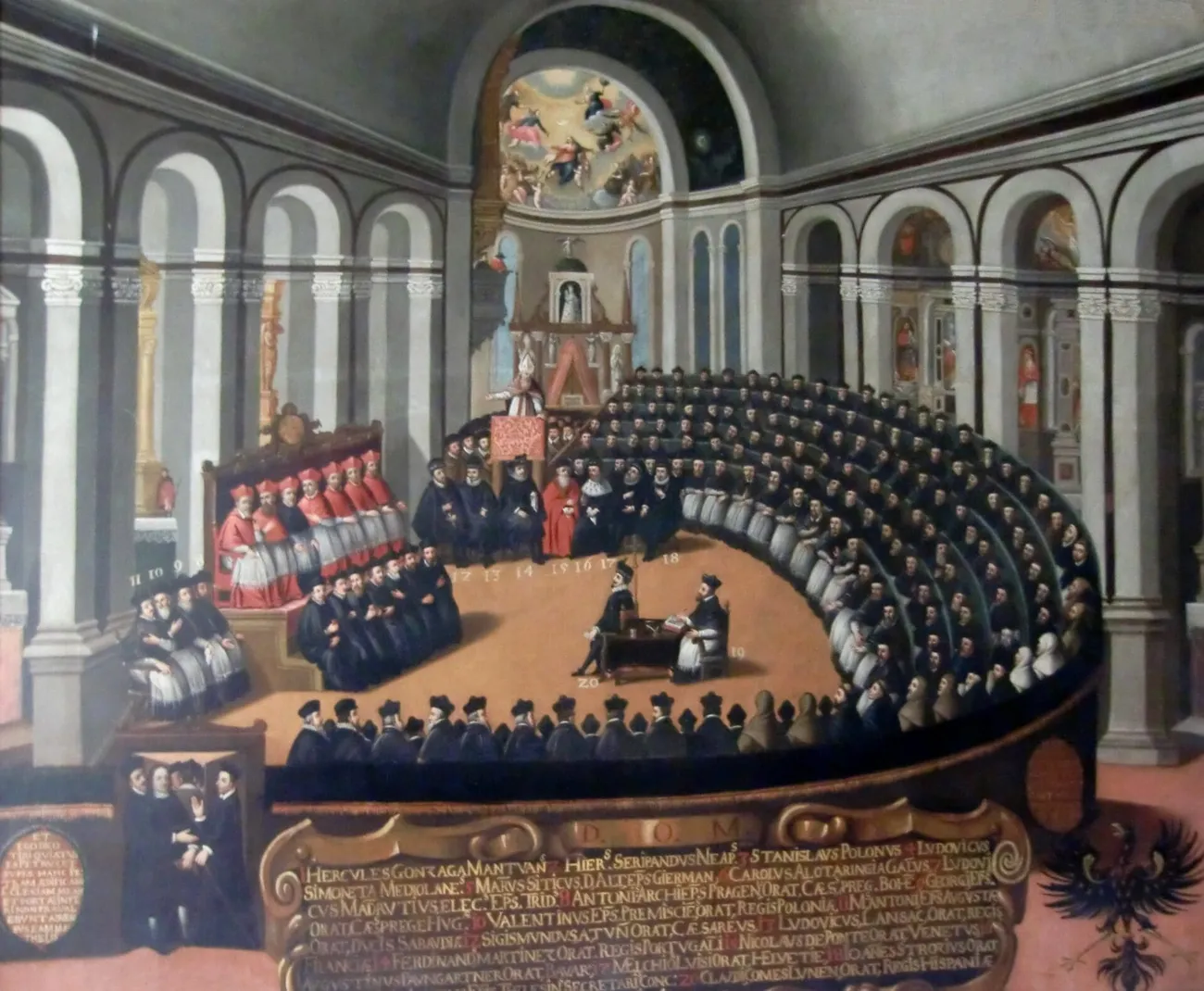
The roots of the Traditional Latin Mass extend far deeper into history than many realize. As Catholics, we believe that the Holy Sacrifice of the Mass finds its origin in Christ’s command at the Last Supper: “Do this in remembrance of me.” This divine mandate established the foundation for all liturgical worship that would follow. Throughout the Scriptures the notion of sacrificial worship is implied, and the early Church recognized this continuity between the Old Testament sacrifices and Christ’s perfect offering.
The liturgy we recognize today contains elements that have remained essentially unchanged since the earliest days of Christianity. St. Justin Martyr’s description of Christian worship from around 155 AD already shows the basic structure familiar to Catholics today – readings from Scripture, a homily, the offering of bread and wine, and Holy Communion. This shows the extent that God has preserved the essential form of worship throughout the centuries.
Much is unknown of the precise details of early Christian liturgy leading up to the fourth century when written accounts become more abundant. However, by the time of Pope St. Gregory the Great (590-604 AD), the Roman Canon (what we now call Eucharistic Prayer I) had taken its definitive form. This prayer, with its references to the communion of saints and its explicit sacrificial language, reveals the consistent theology that has animated Catholic worship for millennia.
According to liturgical historians, many of the prayers in the Traditional Latin Mass date back to the fifth and sixth centuries. This is ratified by numerous historical manuscripts and liturgical books that demonstrate remarkable consistency over time. The Holy and Aged Simeon would recognize much in our traditional liturgy, for its essence remains what the early Christians practiced when they gathered to “break bread” in the upper room.
Many fail to realize how elements like the sanctuary, altar, incense, and ritual gestures have their roots in divine revelation to Moses. The Traditional Latin Mass preserves these sacred connections in a way that reveals the hand of God guiding His Church through the centuries.
A) Early Christian worship and apostolic roots
The Most Holy Sacrifice of the Mass finds its beginning with Christ Himself at the Last Supper when He commanded His apostles to “do this in memory of Me.” This divine mandate established the pattern for all Christian worship that followed. From these sacred beginnings, Christian worship spread rapidly throughout the Roman Empire. By the year 100 AD, over 40 Christian communities had been established throughout the known world, primarily in Asia Minor.
The early Christians, filled with fervent devotion, gathered in small private homes (domus ecclesiae), where the Holy Communion (Eucharist) served as the principal Sunday service. As we read in the Scriptures, these first believers “continued steadfastly in the apostles’ doctrine and fellowship, in the breaking of bread, and in prayers” (Acts 2:42). Although these early liturgies were necessarily simple due to persecution, they contained many elements still present in the Latin Mass missal today.
The earliest celebrations were conducted in Aramaic or Hebrew, the languages Christ and His apostles spoke. This explains why certain words like “amen,” “alleluia,” “hosanna,” and “sabbaoth” were preserved in subsequent liturgical developments despite changes in the primary language of worship. As Christianity spread throughout the Gentile world around 100 AD, Greek became the predominant liturgical language, with the “Kyrie eleison” remaining as a vestige of this period.
By 250 AD, Latin had replaced Greek as the Church adopted the official language of the Empire. The essential form of the Latin Canon as we know it today was largely completed by 399 AD, demonstrating the remarkable continuity of the traditional Mass throughout Church history.
B) The influence of Jewish temple liturgy
To understand how this would take place is to draw upon the relationship between Jewish worship and Catholic liturgy. Contrary to common assumptions that Christian worship originated primarily from synagogue practices, significant scholarship suggests the roots of Catholic liturgy actually trace back to Jewish temple worship.
The Jewish temple’s influence on Catholic worship is evident in several key elements:
Sacred Space – The concept of a sanctuary with an altar of sacrifice
Priestly Ministry – The role of consecrated ministers offering sacrifice
Ritual Elements – The use of incense, holy water, and sacred vessels
Liturgical Structure – Prayers, readings, and ritual actions in a prescribed order
Within the ancient Jewish Temple, the bronze altar of sacrifice finds its parallel in the Catholic altar where Christ’s sacrifice is made present. The golden menorah corresponds to our sanctuary lamp, continuously burning to indicate God’s presence. The Jewish ark of the covenant containing sacred objects parallels our tabernacle housing the Blessed Sacrament.
In essence, early Christian worship maintained the sacrificial character of Temple worship while fulfilling it through Christ’s perfect sacrifice. St. Paul reminds us in Hebrews that Christ is our High Priest who “offered one sacrifice for sins forever” (Hebrews 10:12). This understanding illuminates why the Novus Ordo Mass meaning differs significantly from traditional worship in its emphasis and structure.
C) Codification at the Council of Trent
After centuries of organic development, the Council of Trent (1545-1563) addressed the need to standardize the liturgy amid Protestant challenges to Catholic worship. In its 22nd session (September 1562), the council defined the doctrine of the Mass and established guidelines for its celebration.
The actual codification of the liturgy was entrusted to Pope Pius V, who promulgated the Tridentine Missal in 1570. Importantly, this was not a new creation but rather the standardization of the existing Roman Rite, which could be traced back in all essential elements to apostolic times.
Through his papal bull “Quo Primum,” Pius V allowed only those liturgical rites that were at least 200 years old to continue, effectively preserving the most ancient forms of worship. Additionally, he declared that this Mass was to remain unchanged for all time and forbade the introduction of new liturgical forms.
The Tridentine Mass codified by Pius V remained virtually unchanged until the Second Vatican Council, making the Tridentine Mass vs Novus Ordo comparison one of remarkable stability versus significant innovation. For nearly four centuries, this liturgy served as the universal expression of Catholic worship throughout the Western Church, providing generations of saints with their spiritual nourishment.
How did the Novus Ordo Mass Develop?
Unlike the gradual evolution of the traditional rite over many centuries, the Novus Ordo Mass emerged through a deliberate process of committee-driven reform in just a few years. This dramatic shift represents one of the most significant liturgical changes in Church history, creating a profound distinction between how we approach worship in both forms.
A) Liturgical reforms of Vatican II
The Second Vatican Council opened the door to liturgical reform through its first document, Sacrosanctum Concilium (Constitution on the Sacred Liturgy), promulgated on December 4, 1963. The Council Fathers approved it nearly unanimously with 2174 votes in favor and only 4 against [18]. Reading through the document, one finds the stated aim was “imparting an ever increasing vigor to the Christian life of the faithful” and adapting liturgical elements “to the needs of our own times” [18].
Sacrosanctum Concilium established several key principles for liturgical renewal:
The liturgy consists of both “immutable elements divinely instituted” and “elements subject to change” [18]
Texts and rites should “express more clearly the holy things which they signify” [18]
The faithful should be enabled to understand and actively participate in liturgical celebrations [18]
“No other person, even if he be a priest, may add, remove, or change anything in the liturgy on his own authority” [18]
The Council called for a general “instauratio” (restoration or renewal) of the liturgy while maintaining that “there must be no innovations unless the good of the Church genuinely and certainly requires them” [1]. As Catholics, we believe that the Holy Spirit guides the Church’s development, yet in practice, the implementation would extend far beyond what many Council Fathers originally envisioned.
B) Role of the Consilium and Bugnini
Following the Council, Pope Paul VI established the Consilium ad exsequendam Constitutionem de Sacra Liturgia (Committee for Implementing the Constitution on the Sacred Liturgy) on January 25, 1964 [3]. This committee, initially consisting of 42 members and later expanded to 51, was assisted by more than 200 official consultors and unofficial advisers [3].
Father Annibale Bugnini emerged as the driving force behind the liturgical changes. According to Cardinal Ferdinando Antonelli, “Fr Bugnini has only one interest: press ahead and finish” [3]. Under his leadership, the Consilium rapidly implemented changes through a series of instructions:
Inter Œcumenici (September 1964) – removed the Last Gospel, introduced bidding prayers and allowed vernacular for portions of the Mass [3]
Tres abhinc annos (May 1967) – removed most of the celebrant’s sacred gestures and allowed the canon to be said in vernacular [3]
By May 1966, the Consilium had already devised a completely new form of Mass [3]. What is particularly noteworthy is how an experimental “normative Mass” was presented to bishops at the 1967 synod, but it was poorly received. As Bugnini himself admitted, “the experiment was not a success, and it even had an effect contrary to the one intended” [4].
Nonetheless, after further revisions, Paul VI gave his written approval to the Novus Ordo on November 6, 1968 [19]. The Apostolic Constitution Missale Romanum was signed on April 3, 1969, and the Novus Ordo was published on May 2 to be implemented throughout the Church beginning November 30 [3].
C) Introduction of vernacular languages
Among the most visible changes in the meaning of the Novus Ordo was the shift from Latin to vernacular languages. Initially, Sacrosanctum Concilium took a conservative approach, stating: “Particular law remaining in force, the use of the Latin language is to be preserved in the Latin rites” [18], while allowing limited use of vernacular “in the first place to the readings and directives, and to some of the prayers and chants” [18].
Nevertheless, permissions for vernacular expanded rapidly:
1964: First vernacular Missal in the United States (November 29) with most texts only in English [1]
1965: Permission for preface to be said in vernacular [3]
1967: Permission for canon to be said in vernacular [6]
1971: Permission for all texts of the Mass in vernacular [6]
1974: Complete approved English-language Missal finally appeared [7]
The rationale for this expansion was to promote “full, conscious, and active participation” by the faithful [8], considered “the primary and indispensable source from which the faithful are to derive the true Christian spirit” [9].
In just a few years through committee work rather than organic development over centuries. This striking departure from traditional liturgical evolution – where changes typically occurred gradually over long periods – remains a central point in ongoing discussions about how we approach Catholic worship in both forms. To understand this topic fully, one should read both Council documents and the subsequent implementation instructions to see the path that led from Sacrosanctum Concilium to the liturgy most Catholics experience today.
How the Introductory Rite shapes the focus of Holy Mass?
The moment a priest approaches the altar for Holy Mass speaks volumes about our understanding of sacred worship. This pivotal moment reveals one of the most profound distinctions between the Traditional Latin Mass and Novus Ordo forms of Catholic worship. Let us consider how these two approaches differ in their initial movements and what this reveals about their theological orientation.
1) Prayers at the foot of the altar vs. greeting the people
When attending the Traditional Latin Mass, one immediately notices the priest’s approach to the altar. He does not immediately ascend to it but instead kneels at its foot alongside his server to recite preparatory prayers. This humble posture speaks to the sacrificial nature of what follows – the priest acknowledges his unworthiness before approaching the holy altar where Christ’s sacrifice will be made present.
The Prayers at the Foot of the Altar originated around the 11th Century, and became standard practice throughout the Church [10]. What strikes the observes most is the unmistakably vertical focus – they direct our attention entirely toward God rather than toward one another. The dialogue between priest and server emphasizes our need for purification before entering into the sacred mysteries.
In contrast, the Novus Ordo begins with the priest already at his chair, typically facing the people. After a brief reverence to the altar, he immediately initiates conversation with the congregation [11]. This horizontal orientation fundamentally redirects our initial focus from God to the community gathered together. The Mass thus begins as a communal celebration rather than as a priest’s petition acknowledging his unworthiness before approaching the divine presence.
2) Psalm 42 and its removal
The removal of Psalm 42 (Judica me) perhaps best exemplifies the theological shift between these liturgical forms. In the Latin Mass missal, this psalm holds a central position in the preparatory rites, yet it was completely eliminated from the Novus Ordo.
The words of this psalm powerfully express the priest’s spiritual disposition:
“Judge me, O God, and distinguish my cause from the nation that is not holy: from the unjust and deceitful man deliver me” [12].
Through this prayer, the priest acknowledges his separation from the profane world before entering sacred space. This establishes the sacrificial character of the Mass, as he prepares to ascend to “the altar of God” [13].
What many don’t realize is that this same psalm serves as the Introit for Passion Sunday, creating a profound connection between the opening of Mass and Christ’s Passion [12].
Yet in 1965, reformers removed Psalm 42 while keeping only its antiphon; by 1970, even this vestige had disappeared [12]. Cardinal Antonelli later revealed this change reflected a deliberate move away from emphasizing Mass as sacrifice, which reformers considered a “stumbling block to Protestants” [12].
3) Theological implications of posture and direction
The physical orientation of the celebrant carries profound theological meaning. Throughout Catholic tradition, priests celebrated Mass ad orientem (facing east)—with priest and people alike facing the same direction toward God [14]. This arrangement visibly demonstrates that worship is directed primarily to God, not to the community.
The Novus Ordo introduced the option for the priest to celebrate versus populum (facing the people), which has become standard practice in most parishes despite not being mandated in liturgical law [15]. Cardinal Estevez clarified this was permitted because “it makes communication easier,” yet emphasized that the priest’s “spiritual attitude ought always to be ‘versus Deum per Jesus Christum'” [15].
When the priest faces the people across the altar, the Mass can unintentionally become more performance than sacrifice, more horizontal than vertical in its focus. The traditional Mass emphasizes priest and people approaching God together, while the Novus Ordo often emphasizes the gathered community’s interactions.
These differences in introductory rites are not mere ceremonial variations but reflect fundamentally different theological understandings of what happens during divine worship. The Traditional Latin Mass maintains its focus on sacrifice, human unworthiness, and divine transcendence, whereas the Novus Ordo emphasizes accessibility, community, and active participation of the faithful.
How does Confession and Penitence differ in the two forms of the Mass?
One of the most profound theological shifts between the traditional and reformed liturgies appears in their penitential elements. When examining the Latin Mass versus Novus Ordo, these differences reveal changing attitudes toward sin, confession, and absolution in Catholic worship. What do these changes tell us about our understanding of sin and forgiveness within the liturgical context?
1) Structure of the Confiteor in the Tridentine Mass
The Tridentine Mass features a double Confiteor that clearly distinguishes between priest and people, a distinction that Protestant reformers historically rejected [16]. This separation reflects the Catholic understanding of the unique role of the ordained priesthood. First, the priest kneels at the foot of the altar and recites his Confiteor, followed by the server’s response. Then the server recites the Confiteor on behalf of the people, with the priest responding in turn [17].
The theological depth of the traditional Confiteor particularly is very moving:
“I confess to almighty God, to blessed Mary ever virgin, to blessed Michael the archangel, to blessed John the Baptist, to the holy apostles Peter and Paul, to all the saints, and to you, brethren, that I have sinned exceedingly in thought, word and deed: through my fault, through my fault, through my most grievous fault” [17].
The priest strikes his breast three times during “mea culpa” (through my fault), physically expressing contrition [18]. This embodied prayer acknowledges sin not as a mere mistake but as a grievous fault requiring genuine repentance. Moreover, the entire prayer invokes the communion of saints, showing the vertical dimension of Catholic faith by seeking heavenly intercession.
2) Penitential Act options in the Novus Ordo
In contrast, the Novus Ordo offers three distinct options for the Penitential Act, with the traditional Confiteor being just one possibility. Option A presents a truncated version of the traditional Confiteor, Option B draws inspiration from Psalm 51, while Option C incorporates tropes with the Kyrie [19].
The revised Confiteor (Option A) notably shortens the prayer, removing specific mentions of St. Michael, John the Baptist, and the apostles Peter and Paul, instead referring more generically to “all the Angels and Saints” [20]. This generalization diminishes the vivid sense of the communion of saints that was so present in the traditional form. Additionally, within the Novus Ordo missal, people collectively recite the Confiteor rather than having the server recite it on their behalf.
Option B creates a dialog between priest and people: “Have mercy on us, O Lord” with the response “For we have sinned against you,” followed by “Show us, O Lord, your mercy” and “And grant us your salvation” [19]. This form emphasizes God’s mercy alongside human sinfulness.
Option C merges the penitential rite with the Kyrie, incorporating statements about Jesus that connect to his mission or person before each “Lord have mercy” invocation. For instance: “You were sent to heal the contrite of heart: Lord have mercy” [19]. In this form, the focus shifts significantly from acknowledging personal sin to proclaiming Christ’s works.
3) Loss of absolution prayers
Perhaps the most consequential change involves the removal of certain absolution prayers. After the Confiteor in the traditional rite, the priest says two distinct prayers of absolution. First, “May almighty God have mercy on thee and, having forgiven thee thy sins, bring thee to life everlasting” [17]. Then follows a second prayer: “May the almighty and merciful God grant us pardon, absolution, and remission of our sins” [18].
Throughout the liturgical reforms, these prayers underwent significant modification. The first absolution prayer lost the phrase “dimissis omnibus peccatis vestris/tuis” (“forgive you all your sins”) in 1604 when Pope Clement VIII revised the Tridentine Missal [18]. Later, the Novus Ordo entirely omitted the second absolution prayer that explicitly asked for “indulgence, absolution, and remission” [18].
Cardinal Estevez clarified that these prayers are strictly sacramental—a prayer for forgiveness—rather than the sacramental absolution given in confession [18]. Nevertheless, the modifications represent a subtle shift in emphasis regarding sin and forgiveness within the Mass itself.
The Tridentine Mass versus Novus Ordo comparison reveals more than procedural changes. As some theologians have observed, these modifications reflect a broader trend toward what Guillaume Cuchet termed “post-confessional Catholicism,” where traditional language about sin has sometimes been softened [21]. In fact, some note that terms like “mortal sin” have increasingly been replaced with “grave” or “serious sin” in contemporary practice [22].
This shows the extent to which liturgical changes can impact our theological understanding. The Doctrine of sin and confession, like other Catholic teachings, needs to be preserved in its fullness through our liturgical expressions. As St. Augustine teaches, our prayer shapes our belief, and these changes in penitential practice have profound implications for how we understand our relationship with God and our need for His mercy.
How does the Liturgy of the Word differ both forms of the Mass- Language and Participation?
What impact does language have on our worship? The words we use in prayer shape our understanding of faith itself. When comparing the Traditional Latin Mass versus Novus Ordo, few differences create such immediate contrast as the language we hear and speak during worship.
1) Use of Latin vs. vernacular
Latin has served as the universal language of the Roman rite for centuries, creating a powerful continuity of prayer across generations. The Second Vatican Council maintained that “the use of the Latin language is to be preserved in the Latin rites” [6] while carefully allowing “a suitable place may be allotted to their mother tongue” [23]. Yet in practice, what began as limited permission expanded rapidly beyond what many Council Fathers anticipated.
The liturgical reformers believed vernacular language would promote “full, conscious, and active participation” [6]. As we can see today, most Novus Ordo Masses are celebrated entirely in the local language, though Latin technically remains the normative language according to liturgical law [14].
Throughout the Scriptures, the notion of sacred language is implied. Latin’s sacred function extends beyond mere tradition or preference. As Cardinal Arinze wisely observed, the ancient language “fits a Church which is universal, a Church in which all peoples, languages, and cultures should feel at home and no one is regarded as a stranger” [23]. Furthermore, Latin helps preserve doctrinal precision since, unlike modern languages, its meanings remain fixed rather than evolving over time [24].
2) Scripture readings and lectionary changes
The differences between lectionaries reveal distinct approaches to Scripture. The traditional one-year cycle presented in the Latin Mass missal covers approximately 17% of the New Testament and merely 1% of the Old Testament [25]. By comparison, the Novus Ordo’s multi-year cycle presents 71% of the New Testament and 14% of the Old Testament [25].
The Novus Ordo lectionary follows this structure:
A three-year Sunday cycle (A, B, C), with Year A focusing on Matthew, Year B on Mark (with portions of John), and Year C on Luke [26]
For weekdays, a two-year cycle alternates between Years I and II [26]
The Gospel of John receives special prominence during Lent and Easter in all cycles [26]
Each approach serves different spiritual purposes. The expanded lectionary certainly exposes Catholics to broader scripture portions, especially from the Old Testament. In contrast, the traditional cycle’s repetition allows for deeper absorption of core passages. As one commentator beautifully expressed: “One who immerses himself in the traditional liturgy becomes aware that its annual readings, over time, are becoming bone of one’s bone, flesh of one’s flesh” [27].
3) Homily expectations and theological depth
Should a priest’s preaching change based on the liturgical form? With expanded scripture readings came changed expectations for preaching. The Novus Ordo’s diverse readings present both opportunities and challenges for homilists. At its best, this variety allows priests to explore more biblical themes throughout the year.
Yet some observers note the traditional cycle’s focused repetition fostered deeper theological understanding. To quote one scholar: “The fundamental elements of faith need to be inculcated week after week, day after day; and thus it is pedagogically most appropriate to have certain readings repeated annually” [27].
The traditional readings offer deep familiarity with core scriptural passages, while the expanded Novus Ordo cycle provides broader biblical literacy. This understanding of both approaches enriches our appreciation of Scripture regardless of which Mass we attend.
Overall, the Tridentine Mass versus Novus Ordo approach to Scripture reveals contrasting priorities: the new rite emphasizes comprehensive biblical exposure while the traditional form focuses on deep familiarization with essential passages. This reflects a fundamental shift in how the Church presents Scripture to the faithful in our time.
Is the Offertory a Sacrifice or Symbol?
What happens during the Offertory prayers reveals profound theological differences between the two forms of Catholic liturgy. As Catholics, we believe that every Mass is a re-presentation of Christ’s sacrifice on Calvary, yet how this sacrificial reality is expressed differs remarkably between the Traditional Latin Mass and Novus Ordo.
1) Traditional Offertory Prayers and Their Removal
The Traditional Latin Mass features Offertory prayers that speak directly and explicitly about sacrifice. When offering the host, the priest prays: “Accept, O Holy father, almighty and eternal God, this spotless host, which I, Your unworthy servant, offer to You, my living and true God, to atone for my numberless sins, offenses, and negligences” [28].
As they present the Mass in its true nature – a propitiatory sacrifice for the remission of sins. The priest continues with equally powerful words when offering the chalice: “We offer unto Thee, O Lord, the chalice of salvation, entreating Thy mercy that our offering may ascend with a sweet fragrance” [28].
Throughout these magnificent prayers, which have nourished saints for over a millennium, the words “offer,” “sacrifice,” and “salvation” establish the vertical dimension of worship directed toward God. Yet these prayers were completely removed from the Novus Ordo Missal. This was not accidental – Cardinal Antonelli acknowledged this change was made specifically because sacrificial language was considered a “stumbling block to Protestants” [29].
2) Jewish Meal Prayers in the Novus Ordo
The distinction between Latin Mass and Novus Ordo becomes particularly evident in the replacement prayers. Rather than developing organically from Catholic tradition, the new prayers were instead based on Jewish berakhot (blessings) from the 5th century Babylonian Talmud [29].
The new formulas follow this pattern: “Blessed are you, Lord God of all creation, for through your goodness we have received the bread we offer you: fruit of the earth and work of human hands, it will become for us the bread of life” [30].
These prayers primarily focus on God’s gifts returning to Him rather than on sacrifice for sin. Bishop Schneider has noted they “express the mystery of a banquet” more than “the sacrifice of the Cross” [31]. While beautiful in their own right, they represent a significant theological shift in emphasis.
This shift reflects a fundamental question: Is the Mass primarily a sacrifice or a communal meal? The Catholic Church teaches it is both, but the Traditional Mass clearly emphasizes the former while the Novus Ordo often highlights the latter.
3) Presentation of Gifts by the Laity
The Novus Ordo Mass extends beyond textual changes to include ritual differences. The General Instruction permits “the bread and wine to be presented by the faithful” [32], something previously unheard of in tradition.
This practice symbolizes the laity’s participation in offering the sacrifice and often includes presenting monetary contributions alongside the bread and wine [32]. While this practice is “praiseworthy,” it is “not strictly required” [32], though it has become nearly universal in parish practice today.
The Traditional Latin Mass versus Novus Ordo comparison reveals more than mere preference or aesthetics. These differences represent fundamentally different theological emphases: one predominantly sacrificial, the other predominantly communal. As St. Paul reminds us in 1 Corinthians, “For as often as you shall eat this bread, and drink the chalice, you shall show the death of the Lord, until he come.”
Understanding these distinctions helps us appreciate the richness of our Catholic tradition and the various ways the Church has sought to present Christ’s sacrifice throughout history.
How have the Eucharistic Prayer and Consecration differed in the two Mass rites?
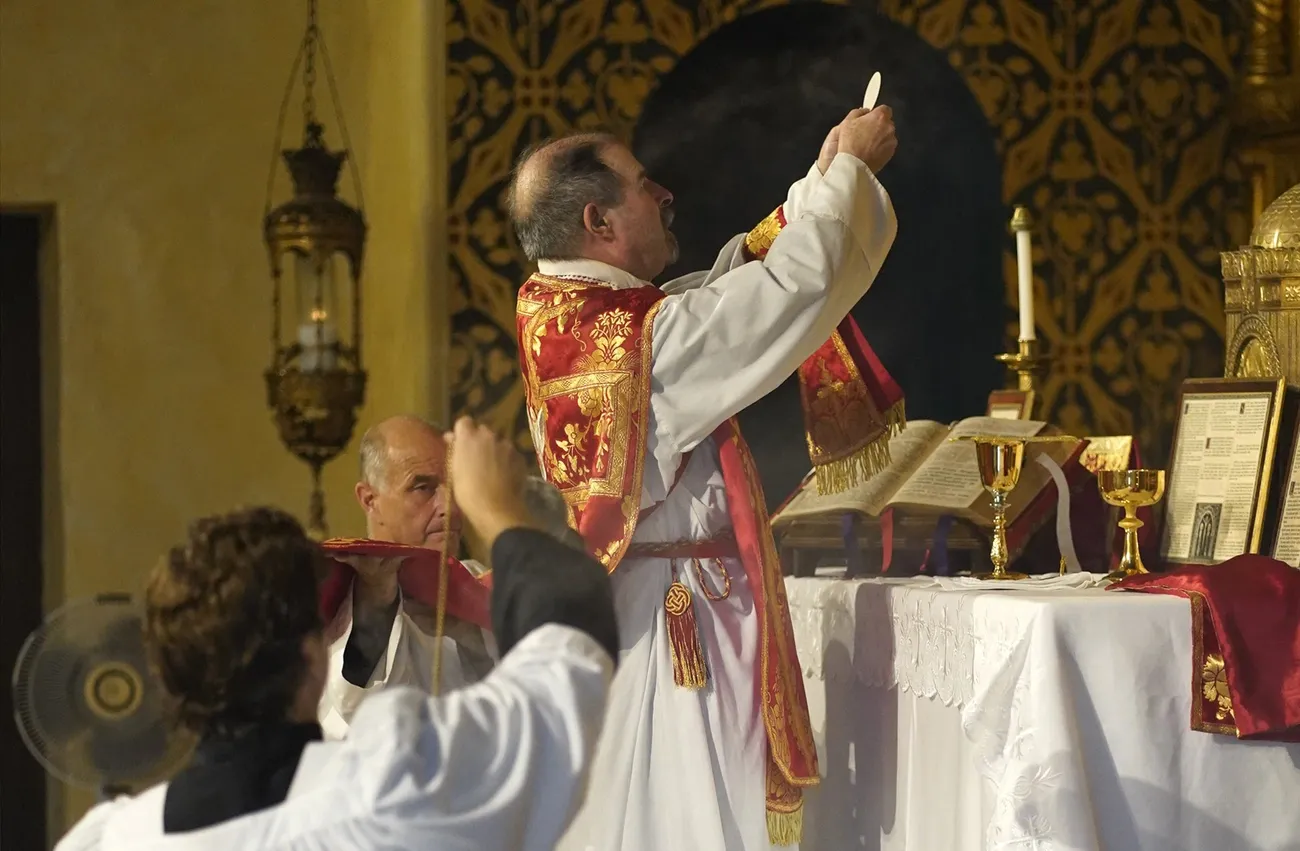
Image Source: America Magazine
At the heart of liturgical worship stands the Eucharistic Prayer—the supreme moment when bread and wine become Christ’s Body and Blood. This is when the supreme sacrifice of Calvary is made present on our altars through the mystery of transubstantiation. Throughout Catholic history, the Roman Canon (now called Eucharistic Prayer I) stood as the only eucharistic prayer in the Latin Mass missal for over a millennium.
1) Canon of the Mass vs. Eucharistic Prayers I-IV
The Roman Canon traces its roots to the mid-fourth century and has remained virtually unchanged since the seventh century [33]. This remarkable continuity is a powerful witness to the Church’s understanding of the Eucharistic sacrifice. In contrast, the Novus Ordo introduced multiple options—Eucharistic Prayers I through IV, plus additional prayers for special occasions. These varied options reflect different theological emphases and historical inspirations.
What are the differences between these prayers?
Their distinct characteristics are:
Eucharistic Prayer I – The traditional Roman Canon, lengthy and rich in saints’ intercessions
Eucharistic Prayer II – The shortest option, drawing from the ancient Anaphora of Hippolytus (third or fourth centuries), primarily suited for weekday Masses [33]
Eucharistic Prayer III – Newly composed after Vatican II, primarily intended for Sundays and feast days [33]
Eucharistic Prayer IV – Incorporates elements from Eastern liturgies, particularly that of St. Basil the Great [33]
The multiplication of Eucharistic Prayers represents a significant departure from liturgical tradition. Throughout the Scriptures the notion of fixed prayers for sacred worship is implied. In the traditional liturgy, the singular Canon served as a pillar of doctrinal stability and sacred continuity.
2) Mystery of Faith: change in placement and meaning
Among the most significant changes when comparing Traditional Latin Mass versus Novus Ordo is the repositioning of the words “mysterium fidei” (mystery of faith). In the traditional form, these words are embedded within the consecration formula itself, whereas in the Novus Ordo meaning, they were removed from that context [34].
Pope Paul VI explained this change noting that these words “are not those of our Lord at the institution of the Eucharist” [34]. As a result, they now serve “as an introduction to the acclamation of the faithful” [34], with multiple response options now available to the congregation [35]. This shows the extent to which the reformers attempted to reshape the liturgy according to historical-critical principles rather than organic tradition.
To understand how this would impact the worship experience is to consider how it shifts focus from the priest’s proclamation of mystery to the people’s response. This is consistent with the more communal emphasis of the reformed liturgy.
3) Handling of sacred particles and gestures
The Tridentine Mass versus Novus Ordo comparison reveals markedly different approaches to the consecrated species. In the traditional rite, the priest joins thumb and forefinger after consecration until purification, showing protection for even the smallest particles [2]. This beautiful reverence acknowledges that even the tiniest fragment contains the whole Christ.
The traditional liturgy also maintains a longer silent period after Communion for prayer and thanksgiving [2]. The silence allows for deeper communion with Our Lord, whereas the tendency in many modern liturgies is to fill this space with music or movement. The priest’s actions at consecration in the traditional form follow a more elaborate, fixed pattern [2], expressing belief in Christ’s Real Presence through physical reverence.
As Catholics, we believe in the Real Presence of Christ in the Eucharist, but how this belief is embodied in liturgical action differs significantly between the two forms.
Much is unknown about the exact prayers used in the earliest Christian Eucharistic celebrations, but the sacred reverence shown in the Traditional Latin Mass for the consecrated elements seems most consistent with the awe-filled worship described throughout Scripture and early Christian writings.
How the reception of Communion and Posture have differed?

Image Source: Catholic Herald
The way we physically receive Our Lord in the Blessed Sacrament speaks volumes about our interior disposition and theological understanding. As Catholics, we believe in the Real Presence of Christ in the Eucharist – Body, Blood, Soul, and Divinity. How does our bodily posture reflect this profound belief? When comparing the Traditional Latin Mass and Novus Ordo, few elements reveal such contrasting theological approaches as the manner of receiving Holy Communion.
1) Kneeling and Receiving on the Tongue
In the Traditional Latin Mass, Holy Communion follows a uniform pattern of reverence – the faithful kneel at the communion rail and receive the Sacred Host directly on the tongue from the consecrated hands of the priest [14]. This posture of humility physically expresses our acknowledgment of Christ’s kingship and our own unworthiness.
The communion rail serves a profound theological purpose – it marks the boundary between the sanctuary (representing Heaven) and the nave (representing Earth) [14]. This is not about separation in the negative sense but rather a sacred demarcation that helps us understand the holy mystery taking place. The rail becomes “an extension of the altar of sacrifice for the laity” [37], allowing us to participate in the sacred mysteries while maintaining proper reverence.
One cannot help but recall St. Thomas Aquinas’ beautiful Eucharistic hymn “Adoro Te Devote” when witnessing the faithful kneeling to receive their Lord: “I devoutly adore You, O hidden Deity.” The physical act of kneeling embodies this devotion in a tangible way.
2) Standing and Communion in the Hand
The Novus Ordo has expanded the available options for receiving communion – permitting standing reception, communion in the hand, and communion under both species [14]. These practices emerged from the liturgical reforms that sought greater accessibility and active participation of the faithful.
In this form, communicants typically stand in line, say “Amen” after the priest declares “The Body of Christ,” and may choose to receive either on the tongue or in the hand [14]. The standing posture has historical precedent in the early Church, particularly on Sundays and during the Easter season, which were considered “little Easters” when the faithful stood to pray in recognition of Christ’s Resurrection.
3) Resurgence of Altar Rails
What has been particularly noteworthy in recent years is the resurgence of altar rails in churches where they had been removed following Vatican II. At St. Anne Church in Georgia, after reinstalling rails in 2024, it was observed that approximately 90% of parishioners chose to kneel, even when receiving in the hand [36]. This speaks to a deep-seated desire among many of the faithful for visible expressions of reverence.
The practical benefits extend beyond symbolism. With an altar rail, the faithful can prepare themselves for reception without feeling rushed [5]. It creates what one priest aptly called “a more reverent and orderly way” of receiving, reducing distractions that “would take away from the beauty of the Eucharist” [36].
The question remains: how does our bodily posture affect our interior disposition? The ancient principle of “lex orandi, lex credendi” (the law of prayer is the law of belief) suggests that how we worship shapes what we believe. Our physical reverence for the Eucharist both expresses and reinforces our faith in the Real Presence.
Conclusion
Throughout our examination of the differences between the Traditional Latin Mass and the Novus Ordo, we’ve uncovered profound theological distinctions that extend far beyond mere aesthetics or language preferences. These two forms of Catholic worship represent fundamentally different approaches to the same sacred mysteries – both valid, yet expressing different dimensions of our faith.
The Traditional Latin Mass, with roots stretching back to apostolic times, maintains a primarily vertical focus. Its prayers, gestures, and sacrificial language reflect a theology centered on divine transcendence and our human unworthiness before the sacred mysteries. When I attend the Traditional Mass, I’m reminded of the words in Psalm 42 (removed from the Novus Ordo): “I will go unto the altar of God, to God who gives joy to my youth.” This ascending movement toward God permeates every aspect of the traditional liturgy.
Conversely, the Novus Ordo Mass, developed in the 1960s, emphasizes horizontal community participation and accessibility. This isn’t to diminish its validity – the same sacrifice is made present – but rather to acknowledge how its prayers and gestures embody a different understanding of communal worship.
These differences become particularly evident in their contrasting approaches to:
Confession – with the Traditional Mass featuring a double Confiteor invoking saints and angels
Offertory prayers – with explicit sacrificial language versus meal-centered blessing prayers
Scripture readings – deep familiarity through repetition versus broader scriptural exposure
Communion practices – uniform kneeling reception versus multiple options
The Traditional Mass provides a profound sense of continuity with generations of saints, while the Novus Ordo offers accessibility that many find spiritually nourishing. Much remains mysterious in our understanding of proper worship, yet as Pope Benedict XVI wisely observed, “what earlier generations held as sacred remains sacred and great for us too.”
According to the Church’s teaching, both forms validly celebrate the same Eucharistic sacrifice. Yet they do so through different theological languages and ritual expressions. The essential truth remains constant – Catholic worship makes present Christ’s sacrifice on Calvary – whether through the ancient prayers of the Traditional Latin Mass or the reformed liturgy of the Novus Ordo.
May this exploration deepen your appreciation for the rich theological heritage we possess in our liturgical traditions, and may we all continue to grow in our love for Christ present in the Holy Sacrifice of the Mass.
FAQs
Q1. What are the main differences between the Traditional Latin Mass and the Novus Ordo Mass? The Traditional Latin Mass is celebrated in Latin, focuses on vertical worship directed towards God, and emphasizes sacrificial language. The Novus Ordo Mass is typically celebrated in vernacular languages, emphasizes community participation, and allows for more options in prayers and gestures.
Q2. How did the Traditional Latin Mass develop historically? The Traditional Latin Mass has roots tracing back to apostolic times. It evolved gradually over centuries, with its essential form largely completed by the 4th century. The Council of Trent in the 16th century standardized this liturgy, which remained largely unchanged until the 20th century.
Q3. Why was the Novus Ordo Mass introduced? The Novus Ordo Mass was introduced following the Second Vatican Council (1962-1965) to promote greater participation of the faithful, adapt the liturgy to modern needs, and make the Mass more accessible through the use of vernacular languages.
Q4. How do communion practices differ between the two forms of Mass? In the Traditional Latin Mass, communicants typically kneel at an altar rail and receive the Host on the tongue. In the Novus Ordo Mass, standing reception and receiving communion in the hand are permitted options, though kneeling and receiving on the tongue remain valid.
Q5. Are both forms of the Mass considered valid by the Catholic Church? Yes, both the Traditional Latin Mass and the Novus Ordo Mass are valid forms of Catholic worship. They celebrate the same Eucharistic sacrifice, albeit with different expressions of Catholic theology and liturgical practices.
References
[1] – https://adoremus.org/2022/07/the-second-vatican-council-and-the-reform-of-the-rite-of-mass-a-short-history-of-the-roman-rite-of-mass-part-xviii/
[2] – https://www.vatican.va/archive/hist_councils/ii_vatican_council/documents/vat-ii_const_19631204_sacrosanctum-concilium_en.html
[3] – https://thecatholicherald.com/the-strange-birth-of-the-novus-ordo/
[4] – https://www.thecatholicthing.org/2022/09/07/liturgical-reform-the-council-and-the-consilium/
[5] – https://churchlifejournal.nd.edu/articles/how-the-novus-ordo-mass-was-made/
[6] – https://www.ewtn.com/catholicism/library/latin-and-vernacular-language-in-the-roman-liturgy-4238
[7] – https://adoremus.org/2018/07/translating-history-50-years-vernacular-liturgy/
[8] – https://www.togetheratonealtar.catholic.edu.au/explore/vatican-ii/
[9] – https://churchlifejournal.nd.edu/articles/the-liturgy-prior-to-vatican-ii-and-the-councils-reforms/
[10] – https://www.sjcacademy.com/blog/prayers-at-the-foot-of-the-altar
[11] – https://lmsbloomington.wordpress.com/2015/04/24/a-brief-walkthrough-of-the-mass-the-prayers-at-the-foot-of-the-altar/
[12] – https://onepeterfive.com/armor-armament-abandoned-priestly-prayers-purged-part-judica/
[13] – https://www.liturgicalartsjournal.com/2018/10/meditations-on-judica-me-psalm-42-of.html
[14] – https://catholicchurchofenglandandwales.com/tridentine-vs-novus-ordo
[15] – https://www.catholicworldreport.com/2024/07/30/from-the-latin-mass-to-the-novus-ordo-how-did-the-mass-change/
[16] – http://www.catholicapologetics.info/modernproblems/newmass/ordo.htm
[17] – https://www.latinmassschedule.com/Resources/A COMPARISON between the old and new liturgy.pdf
[18] – https://en.wikipedia.org/wiki/Confiteor
[19] – https://www.eucharisticrevival.org/post/do-this-in-remembrance-of-me-part-9-forms-of-penitential-act
[20] – https://adoremus.org/2025/03/the-penitential-act-of-the-mass-what-it-is-and-what-it-is-not/
[21] – https://www.traditionsanity.com/p/why-the-traditional-rite-of-confession
[22] – https://www.traditioninaction.org/HotTopics/a054htConfession_4_Somerville.htm
[23] – https://www.catholicnewsagency.com/news/258439/from-the-latin-mass-to-the-novus-ordo-how-did-the-mass-change
[24] – https://www.quora.com/What-do-you-think-of-the-Latin-Tridentine-mass-and-should-it-be-brought-back-to-replace-the-Novus-Ordo-mass-today
[25] – https://futurechurch.org/uncategorized/how-the-lectionary-was-formed-and-revised/
[26] – https://www.usccb.org/faq/questions-about-lectionary
[27] – https://www.newliturgicalmovement.org/2013/11/is-reading-more-scripture-at-mass.html
[28] – https://www.prayinglatin.com/traditional-latin-mass-prayers/
[29] – https://wdtprs.com/2015/04/ask-father-using-the-traditional-offertory-prayers-in-the-novus-ordo-wherein-fr-z-rants/
[30] – https://lms.org.uk/missals
[31] – https://praytellblog.com/index.php/2012/07/19/putting-back-whats-missing-in-the-new-mass-part-iii-the-offertory-prayers/
[32] – https://adoremus.org/2024/08/what-is-included-in-the-presentation-of-the-gifts/
[33] – https://adoremus.org/2023/03/rite-questions-q-why-does-the-priest-choose-different-eucharistic-prayers-at-mass/
[34] – https://www.catholic.com/qa/why-were-the-words-of-the-mystery-of-faith-taken-out-of-the-consecration-in-the-new-mass
[35] – https://www.catholicnewsagency.com/column/51777/the-mystery-of-faith
[36] – https://www.mycatholicsource.com/mcs/cg/latin_mass_and_catholic_tradition/tridentine_mass_vs_novus_ordo.htm
[37] – https://www.ncregister.com/blog/the-deeper-meaning-of-receiving-at-the-altar-rail
[38] – https://www.ncregister.com/features/the-return-of-altar-rails
[39] – https://www.catholic365.com/article/47736/15-reasons-why-every-catholic-church-should-have-an-altar-rail.html
